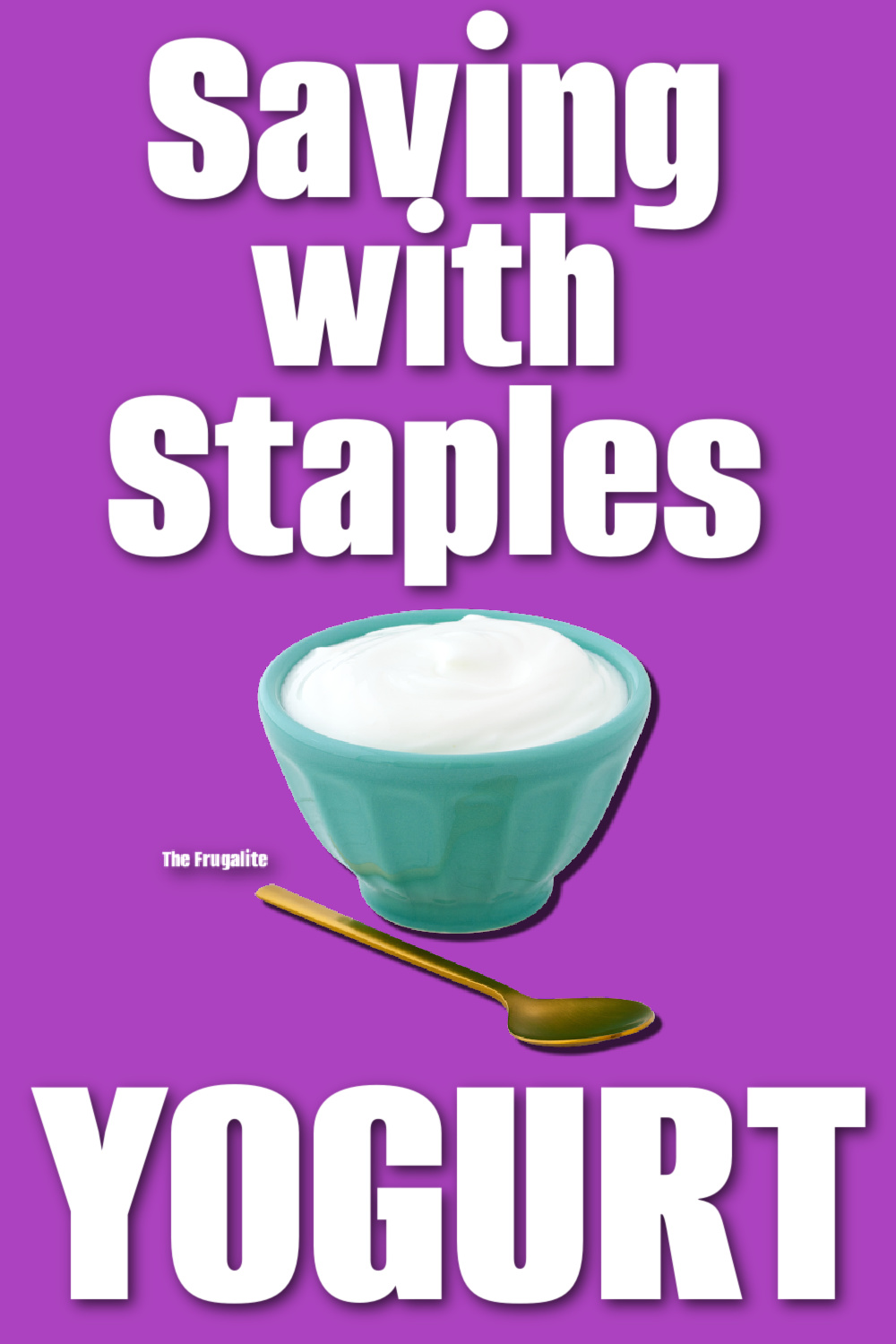(Psst: The FTC wants me to remind you that this website contains affiliate links. That means if you make a purchase from a link you click on, I might receive a small commission. This does not increase the price you’ll pay for that item nor does it decrease the awesomeness of the item. ~ Daisy)
Saving with Staples is a series where I will look at a pantry staple (like yogurt) and consider its nutritional value. Then, I will investigate the economics of this staple: what is the most cost-effective way to buy it. Finally, I will offer some suggestions on how to eat and serve this staple to get the most benefit from the savings that it offers.
While you might only think of yogurt as something that comes in a little plastic tub with a tinfoil lid, it has a great deal of power as a pantry staple. Let’s see how yogurt adds up as a staple to save with.
What are the health benefits of yogurt?

According to Registered Dietician Julia Zumpano, some varieties of sweetened yogurt, such as the fruit bottom version, can contain all of the sugar recommended for you for the entire day! Going with a plain version, whether Greek-style or regular, can help you get all of the health benefits without the sugar hit.
Healthy yogurt packs a healthy “punch” of nutrients for your body, including:
- protein – did you know that Greek yogurt has TWICE the protein as regular yogurt???
- calcium – I think we have all heard a lot about how we need calcium to build strong teeth and bones: yogurt has it!
- probiotics – This is one of the great benefits of eating cultured products. However, as Julia Zumpano, RD recommends, look for the label that indicates your yogurt contains live cultures.
So, when you buy healthy versions of yogurt, there are many health benefits for you to enjoy. These include improved heart health through lower cholesterol and blood pressure, and yogurt has been found to “prevent long-term weight gain,” which is also good for your heart. Win-win-win!
Given all of these benefits and the fact that it is unique in offering us beneficial bacteria for our gut health, it should come as no surprise that yogurt is considered one of the world’s 100 healthiest foods (specifically grass-fed yogurt).
What are the frugal ways to buy yogurt?
I compared a number of ways to buy yogurt as I prepared this article. To be honest, I was absolutely shocked, as the “market” did not appear to behave in the way I expected, counter to basic logic. Why? I am not sure, but here is what I found:
I strongly expected that larger containers of plain (dietician recommended) would be much less expensive than the small, plastic tubs of sweetened (NOT dietician recommended). In fact, this was not always the case!
I think most people would be familiar with the 750-gram tall white plastic tubs, which are just over 1.5 pounds. While I found one no-name brand of plain, non-fat yogurt for about $2, there were multiple types and brands of tiny tubs available for approximately the same price by weight. Want to add some sugar to your no-name brand yogurt? That was the same price, but they had sneakily reduced the size of the container so that it contained 1.43 pounds. Hmmmmm.
One trend that was quite clear was that Greek is usually around twice the price of regular, or even more! The cheapest plain tub of Greek I could find, at 908 grams weighing two pounds, was $4.25. So, even though you get twice the protein, you are paying for it. That really made me think twice about buying Greek yogurt if I did buy any. (I make my own kefir at home, and I can really see why, with these prices!)
Another general trend was that organic Greek yogurt was more expensive than regular Greek, with a container of just over one pound costing almost $4.
Without any compelling bulk options for buying yogurt, it seemed quite expensive to me. I was unable to find any options to buy it at our local “wholesale” store. If you could buy several pounds at a time, that might make a difference. However, all of this got me thinking about when I used to make yogurt at home. More than ever, it would be worth it…
Making yogurt at home is easier than you may think!

My own homemade recipe was an easy version of the thermos method. In a local thrift shop, I found an off-grid yogurt maker that was basically a large thermos. Put the warmed milk with fresh inoculant in the Yogotherm overnight, and voila! Yumminess in the morning!
One of my friends used another method that she loved: she warmed up her oven and then turned it off. She put the warmed milk with the fresh yogurt inoculant in a baking dish in the warmed oven. Her yogurt would be ready in the morning, all set to mix with her granola and fruit.
What are the potential cost savings here, you might ask? I have done the calculations: please forgive some odd numbers, as I am converting Canadian dollars to American dollars and the metric system to imperial!!! My cost for a liter of organic milk is just under $2, and milk weighs over 2 pounds per liter. Therefore, I can make my organic yogurt for $1 per pound. The cost to buy organic whole milk yogurt locally is approximately $3.61 for 1.43 pounds. That is two and a half times more expensive! So, there are BIG savings to be had for taking a bit of time in your week to make your own yogurt.
Although this article is about yogurt as a staple, I am going to put a brief comment here about making kefir at home. Why? I used to buy both until I found, over time, that you can use kefir for everything that you use yogurt for.
There are two more benefits to kefir, as well: it is more diverse in terms of bacterial and yeast cultures, and its production requires no warming of milk, as the culturing is done by live grains called kefira. If you are interested in learning more about making kefir at home, check out this introductory How To Guide on my website. The cost savings relative to buying a liter of organic kefir are around the same as for yogurt or slightly better.
There are a number of creative ways to use yogurt in lean times.
When times are difficult, making your own or buying plain yogurt in bulk will be especially helpful. This is because it can be repurposed in so many different ways.
Not a lot of money in your budget for treats or desserts? Adding a small amount of jam or seasonal fresh fruit to your plain yogurt can be a delicious dessert. A special occasion coming up?
- This Frugalite article shares how you can make a parfait to wow your guests.
- A cold melon soup is a refreshing treat in the summer.
- When cucumber is in season, you might enjoy this cold soup that features yogurt and dill.
- If you have kids at home over the summer, why not get them involved in making their own (healthy, but don’t tell them that!) frozen yogurt pops?
Did you know that it can be a great base for a simple salad dressing, or you even make your own dip or cheese with it? The Frugalite can show you how. The World’s Healthiest Foods website has a number of creative options for yogurt, including this creamy curry dressing for a tasty chef’s salad.
In researching for this article, I was interested to learn that yogurt is also a good marinade for meat and that you can also use it to make a delicious fish meal.
You gurt I gurt: We all gurt for yo-gurt!
Yogurt is a staple with a surprising range of uses. Could you see yourself trying any of the thrifty tips offered here? Do you have one you can share with us? Please tell us in the comments below.
About Colette
Colette is passionate about sharing her knowledge of thrifty living and self-sufficiency. She has developed her skills in self-reliance living in the suburbs, the city, and more recently, on her own Half-Acre Homestead. Colette lived five years completely off-grid and without running water in an eight by 24 foot tiny home while designing and building her own 18 by 24-foot eco-cabin. She has just launched her website, Half Acre Homestead. Colette invites you to stop by and visit this work in progress! Coming soon in 2022 is her exciting new online program. Interested in Resiliency, Preventative Health, and Self-Sufficient/Off-Grid Housing (to name a few!)? Stay tuned for more details!












6 thoughts on “Saving With Staples: Yogurt”
Well done!!
Nice detailed article.
Thanks for doing the math!!
Hi K8, Thank you so much. I certainly found the pricing of yoghurt confusing!!! What is certain, however, is that you will SAVE if you make it yourself! You are most welcome. Wishing you the best with some great yoghurt adventures!
When I make yogurt, I prepare it as usual, and then I wrap it in a towel and stick it in the microwave overnight (turned off!!!!!) with a couple bottles of hot water. It’s ready by the next morning. You could use any well-insulated container for this, especially with the bottles of hot water.
Hi JT, Thanks for mentioning that the microwave should be TURNED OFF! We want yoghurt, not exploding yoghurt! This is a great tip, as it is accessible and something most people could do. Much appreciated!
Don’t forget the multitudes of fresh fruit additions to yogurt :
Blueberries, strawberries, peaches, fresh apricots, plums, and maybe even apple sauce (don’t forget the cinnamon!)
Then you can also make your own Tzatziki sauce (don’t scrimp on the garlic ! ) for DIY gyros or as a dressing for cucumbers, zucchini, or a regular salad.
Hi Marc, Yum yum yum…..all of your fresh fruit selections were so delicious, I had difficulty choosing. I’m all for lots of garlic, so I’m sure I would enjoy your Tzatziki sauce. Thank you for sharing these tasty suggestions. Wishing you the best!